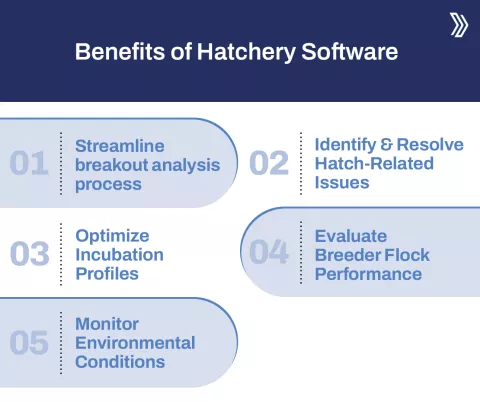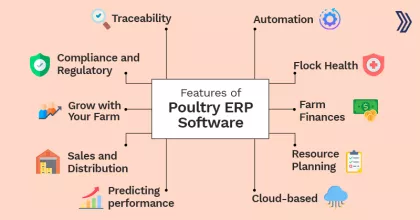In order to achieve good hatchability and improve the quality of chicks, the bird eggs need to be managed carefully from the time they are laid. Environment conditions, transport, pre-storage incubation, storage etc, are all important. Breakout analysis is a valuable procedure which can be used to solving hatch related problems. By including breakout analysis as a part of the quality control procedure, hatch results can be improved in the long term.
Published 07 May 2024
Hatch Breakout Analysis: A Useful Method to Improve Performance

Running a successful poultry hatchery requires a deep understanding of the complex processes involved. In today's competitive landscape, using the advanced power of technology can give your hatchery a significant edge.
The advanced hatchery software is a game-changing tool that streamlines operations, enhances efficiency, and ultimately boosts the profitability of the business.
For high-performing poultry businesses, the requirement is for a robust hatchery management system. This powerful software solution is designed to optimize every aspect of your operations, from tracking incubation parameters to monitoring embryo development.
One of the key features of a top-notch hatchery management system is its ability to facilitate breakout analysis, a critical and very important process that can unlock invaluable insights into your hatchery's performance.
But what exactly is breakout analysis, and why is it so crucial? Let's find out.
What is Breakout Analysis?
Breakout analysis, also known as hatch breakout or hatch residue analysis, is an important and powerful diagnostic tool that helps unravel the mysteries surrounding embryo mortality A hatch breakout is a useful tool for solving hatch-related problems and helping improve certain areas to enhance overall performance.
In a nutshell, breakout analysis is carefully examining clear or unhatched eggs by opening them up to understand at what stage of incubation embryo mortality has occurred. This is very important, the reason being by carefully examining unhatched eggs at various stages of incubation, you can pinpoint the root causes of hatch failures and take proactive measures to optimize your operations.
To perform breakout analysis select sample trays from different positions within the incubator and conduct a thorough analysis of the unhatched eggs.
The five sample setter or hatcher trays (chosen from different positions within the incubator) should be identified and then the analysis should proceed.
Breakout Analysis can be carried out in three distinct stages:
- Fresh Hatching Eggs: Examining eggs before incubation can reveal potential issues with breeder flock health, nutrition, or egg handling.
- Candling Eggs at 7-12 Days: Candling during early incubation can identify fertility problems or early embryo mortality.
- Breakout at Hatch Time: Analyzing unhatched eggs at the end of the incubation period can shed light on late-stage embryo mortality and hatch-related issues
Why Perform Breakout Analysis?
It is a less-known fact that as a hatchery owner, you might be throwing away valuable information in your hatchery waste. This data can do wonders, and can help you solve problems related to hatchery and breeder flocks.
This valuable information held by the unhatched eggs is very important to improve hatchability & profitability. Breakout Analysis is performed for various such reasons.
One good reason to perform the breakouts is to understand in detail the causes of a disappointing hatch. In some cases, hatches do not go as planned and the number of chicks is bound to be way less than the actual estimate. At such times, breakout analysis is a reliable way of finding out what the problem is.
In some cases, a breakout analysis is used to compare and evaluate new incubation profiles with the current ones and improve results accordingly.
With the right choice of poultry management software, examining the weekly/monthly data and reports to perform periodical analysis, is not a difficult job.
Benefits of Hatchery Software while doing Breakout Analysis
By leveraging the power of a comprehensive and advanced hatchery software solution, you can streamline the breakout analysis process and explore a world of benefits for your hatchery
- Identify and Resolve Hatch-Related Issues: Breakout analysis can help you pinpoint the root causes of disappointing hatches, enabling you to take corrective actions and improve hatchability rates on time.
Optimize Incubation Profiles: Comparing results from new incubation profiles with your current practices can help you refine your processes and enhance the overall performance.
Image
- Evaluate Breeder Flock Performance: By analyzing historical data from breakout analyses, you can assess the performance of your breeder flocks, identify potential issues, and make informed decisions regarding flock management through advanced software, which is not possible from traditional software
- Monitor Environmental Conditions: Breakout analysis can reveal the impact of various environmental factors, such as temperature, humidity, and ventilation, on embryo development, allowing you to make necessary adjustments.
Interpretation of Results
In order to understand the complete picture, the results of a breakout analysis should be combined with other data on the app. This includes hatchability records, incubation information, information on hatch timings, and breeder performance records. A poultry management software can help you keep track of all this data without much of a hassle.
Once you have the records, it is important to know or understand that there are two main periods of embryo mortality.
- 3-5 days
- 17-19 days
A very high mortality at any other development stage is not a normal condition. Usually, high incidences of mortality at a particular development stage indicate an acute problem. Understanding the embryo abnormalities is as important as the rest of the procedure.
They can be associated with specific problems related to nutrition, incubation, diseases, etc. However, one should also know that some abnormalities can be a result of multiple problems as well.
An experience of hatch breakouts with a perfectly fine hatching flock is very important to understand the difference between what is normal and what is abnormal.
Empowering Hatchery Management with Livine
Livine's poultry hatchery ERP software is more than just an advanced powerful tool—it's a game-changer for the poultry industry. With Livine, the complexities of hatchery operations become seamless. It's more like a trusted partner for your business offering tailored solutions for every aspect of hatchery management.
In the ever-evolving world of poultry hatchery operations, embracing cutting-edge technology is no longer an option – it's a necessity. By investing in the best hatchery software you can unlock a world of opportunities to optimize your processes, enhance efficiency, and ultimately drive sustainable growth for your business.
As an egg tells a detailed story of the timeline of events, starting from when the egg was formed inside the hen all of the way to the hatching process, a brief amount of time spent on performing breakout analysis will pay large dividends by increasing the overall efficiency.
When combined with other useful data, breakout analysis is a very useful hatchery management procedure.
Embrace the future of hatchery management today and watch your hatchery soar to new heights of success. Book a demo today!
By leveraging advanced cutting-edge technology, the best hatchery software empowers you to make data-driven decisions, identify potential issues early, and implement corrective measures promptly.
Livine’s poultry management software offers a unique hatchery module that enables you to manage your hatch by analyzing all the data and performing monthly checks to improve the overall profit.







